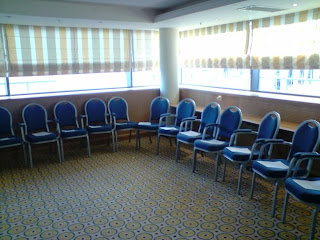
Throughout the conference I was talking to anyone who would give me an ear about a new idea I'd like to pursue: the Agile Welcoming Circle. To get further input on this idea, I held an open space session and invited everyone to come talk. If you have ideas/concerns/comments, please comment on this blog or join the Agile Welcoming Circle discussion group. Pictured right, thanks to Hubert Baumeister, I am describing the Open Spaces session.
60-Second Pitch
The Agile Welcoming Circle is a way to help get people plugged into the Agile community. It provides a landing page, which describes the common basic principles of Agile, and allows people to pay dues ($100/yr?) to join a facilitated discussion group. Their dues give them direct access to a list facilitator, who will get to know newcomers by identifying their interests and then connecting them to an appropriate community--be it a conference, user group, list serve, etc. Once the newcomer shows up at one of these events, as can be vouched for by another community member, they get a Certificate of Completion--meaning they've demonstrated some kind of a commitment to the community. This Certificate is something we'd be happy to see members put on their resumes, because all it really means is that they agree to support the community in some way. So, for example, a newcomer who wanted to learn about TDD would get hooked up with a code camp, and later may return to ask about pair programming.
The first facilitator would be me, but soon it would be run by a committee--and would be supported through Welcoming Circle dues (I think a portion of the proceeds would go to facilitators, and the rest, say 70%, gets dumped back into the program budget, to sponsor more local conferences, speaker travel expenses, etc.). The facilitators would also work on a program to increase retention after the Certificate of Completion, for example, by tracking/logging activity on a new social media channel on the main site (thereby creating an MVP list), or other means. I see this as a way to reach an audience that the Agile Skills Project, with all its overwhelming depth, couldn't reach--the newcomers.
Open Space Ideas
The biggest two concerns I've been hearing about this program are about retention after the initial subscription, and about yet another paper-based certification. Yet this time I think it's different--there will be no easy way for a cottage industry to build up around this, as its revenue is very constrained. By keeping registration costs low, it makes the whole program more democratic-it is a community-based system built to support community learning. Imagine, as Sumeet Moghe proposed (a leader in the Thoughtworks Learning Community), a great river of free information available on the Agile Welcoming Circle's member page--no simple RSS feed--but a Web 2.0 / Enterprise 2.0 flow of information that gets commented on / rated by readers, and then high-rated content comes to the home page. It would become a matter of prestige to get highlighted on the home page--and people who participate in comments or who publish would have to be paying members. The information is free--publishing is not (but rating is free). Editors/facilitators would also be able to promote content to the home page. We could also recognize helpful members through an MVP program.
Background
This discussion initially was focused around my frustration with the slow growth for the Agile Skills Project. I told people like Marc Bless and Cory Foy that I was going to drop out of the project, and they weren't happy with that. So I started talking about what I have energy for--helping the newcomers to our community. The idea is simple enough to try out, but it diverges from the charter of the Agile Skills Project, so I needed something new. I also want to devote more time to this project than I gave to the ASP, and to do that, I need a revenue model. I don't think anyone should make enough money out of this Welcoming Circle to make it a full-time job, but I do think it would be nice if it could pay for one day per month, or even one day per week, for several facilitators, depending on demand.






